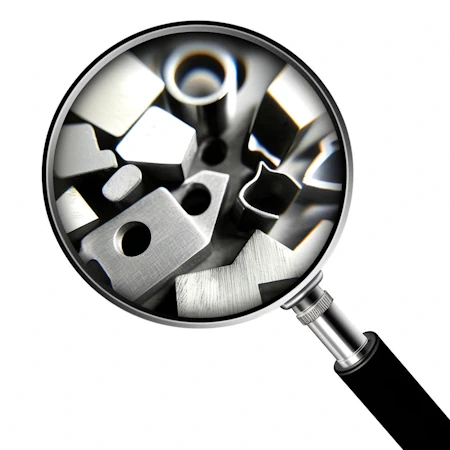Back To Browse
Titanium
Titanium 5Al-2.5V
Annealing Procedure
For full anneal, heat to 718-843 C(1325-1550 F) 4 hours, air cool. For intermediate stress relieving, heat to 538-650 C(1000-1200 F) for 1 hour, air cool.
Applications
Primarily employed in aircraft engine and airframe applications.
Cold Workability
The cold work characteristics of this material is similar to that of a moderately tempered austenitic stainless steel. In multiple cold forming operations, intermediate stress relief is recommended to prevent tearing or other material damage. Post-work annealing is required to reattain optimum performance characteristics.
Forgeability
Rough work at 1010-1038 C(1850-1900 F) and finish at 954-1010 C(1750-1850 F).
Formability
May be hot or cold formed using hydropress, power brake, stretch or drop hammer methods. Similar in characteristics to 300 series stainless steels.
Heat Treatability
This alloy is not hardenable by heat treatment.
Hot Workability
Hot forming will reduce both the springback and required forming forces, and will increase the overall ductility of the material.
Machinability
As a family, titanium and its alloys have developed a mystique as a nightmare to machine. This is simply not the case. Experienced operators have compared its characteristics to those found in 316 stainless steel. Recommended practice includes high coolant flow(to offset the material's low thermal conductivity), slow speeds and relatively high feed rates. Tooling should be tungsten carbide designations C1-C4 or cobalt type high speed tools.
Other Physical Properties
Beta Transus (F +/- 25) 1900
Principle Design Features
This non-heat treatable, alpha alloy combines good weldability with stability and excellent strength from cryogenic through elevated temperatures. It is available at the mill level in sheet, strip, plate, bar, billet, extrusions and wire. Beta Transus (F +/- 25) 1900.
Weldability
Rated as "good" in terms of weldability.
Known Forms
Casting
Closed Die Forgings
Flanges
Flat Bar
Forgings-Discs
Hexagon Bar
Open Die Forgings
Pipe-Seamless
Pipe-Welded
Plate
Round Bar
Seamless Rolled Rings
Sheet
Square Bar
Strip
Tube-Round (Seamless)
Tube-Round (Welded)
Wire Rod
Wire-Round
Wire-Welding
Billet
Coil
Contour Rings
Fittings
Forgings-Upset
Ingot
Mandrel Rings
Shafts
Shapes-Extruded
Valves
Welded Rings
Additional Data
Specifications
4910,4926,4966,B265,B348,B381,F-83142,T-81556,T-81915,T-9046,T-9047,R54520Dismiss
Chemical Elements
| Aluminum | 4 - 6 |
| Carbon | 0.08 max |
| Hydrogen 2 | 0.02 max |
| Iron | 0.5 max |
| Nitrogen | 0.05 max |
| Oxygen 2 | 0.2 max |
| Tin | 2 - 3 |
| Titanium | Balance |
Physical Properties
Density: 0.162lb/in³
Electrical Resistivity: 157µΩ·cm
Melting Point: 2910°F
Specific Heat: 0.125BTU/lb·°F
Thermal Conductivity: 0.375BTU/hr·ft·°F
Mechanical Properties
Modulus of Elasticity – Tension: 16MSI
Reduction of Area: 25%
Thermal Expansion
| Condition | Min | Max | Expansion Coefficient |
|---|---|---|---|
| Annealed | 32 °F | 212 °F | 5.2 µin/in/°F |
| Annealed | 32 °F | 600 °F | 5.3 µin/in/°F |
| Annealed | 32 °F | 1000 °F | 5.3 µin/in/°F |
| Annealed | 32 °F | 1200 °F | 5.4 µin/in/°F |
| Annealed | 32 °F | 1500 °F | 5.6 µin/in/°F |
Find the metal you're looking for today.

